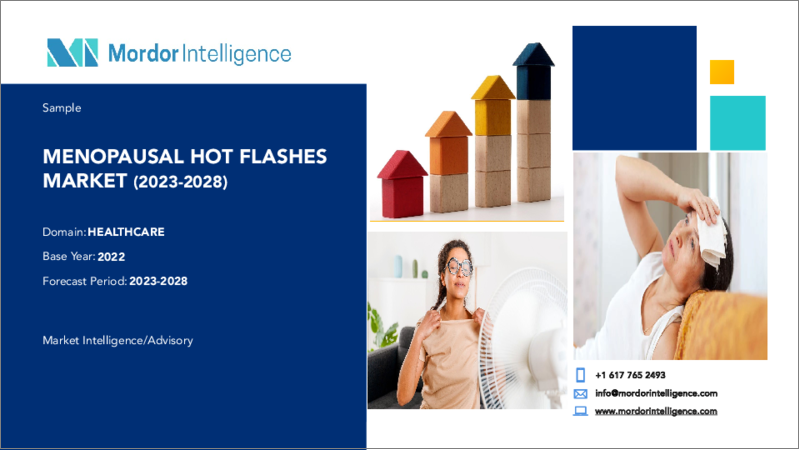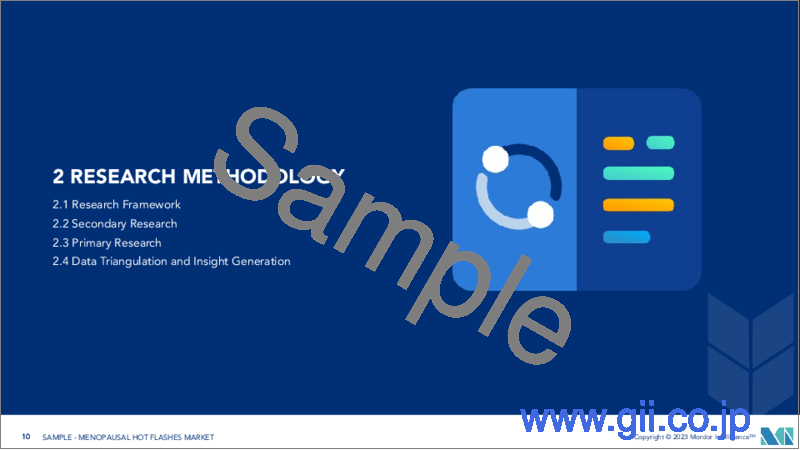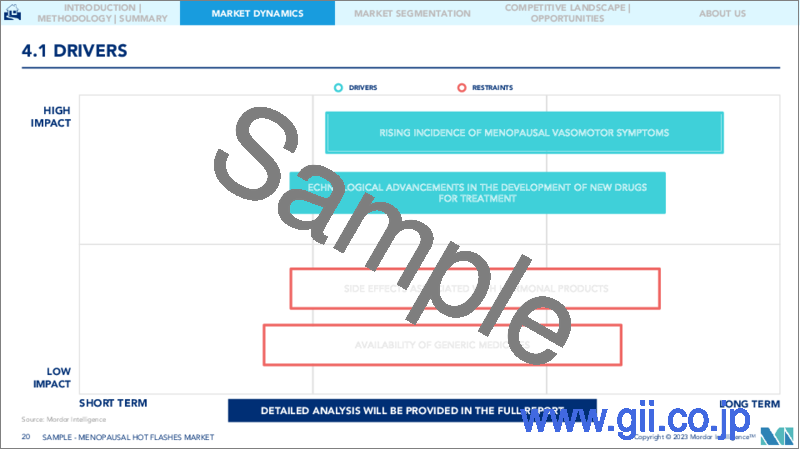|
|
市場調査レポート
商品コード
1197566
ホットフラッシュ更年期障害市場- 成長、動向、予測(2023年~2028年)Menopausal Hot Flashes Market - Growth, Trends, and Forecasts (2023 - 2028) |
||||||
|
● お客様のご希望に応じて、既存データの加工や未掲載情報(例:国別セグメント)の追加などの対応が可能です。 詳細はお問い合わせください。 |
|||||||
| ホットフラッシュ更年期障害市場- 成長、動向、予測(2023年~2028年) |
|
出版日: 2023年01月23日
発行: Mordor Intelligence
ページ情報: 英文 117 Pages
納期: 2~3営業日
|
- 全表示
- 概要
- 目次
ホットフラッシュ更年期障害市場は、予測期間中にCAGR3.4%を記録すると予測されています。
COVID-19の大流行は、ヘルスケアシステムに深刻な課題をもたらし、病院や診療所における入院および外来サービスを大幅に削減しています。政府による閉鎖措置や規制は、更年期障害に苦しむ患者の生活に影響を及ぼしています。例えば、2021年5月にWomen and Healthに掲載された論文によると、血管運動症状(VMS)などの更年期の不快な症状に悩む女性は、医師探しや更年期ホルモン療法の調達に苦労しています。そのため、更年期障害治療薬や治療法の需要に影響を与え、市場の成長を鈍化させています。しかし、COVID規制の解除や治療サービスの再開により、研究対象市場は今後2~3年でCOVID-19の大流行による落ち込みから回復すると予想されます。
更年期の血管運動症状の発生率の上昇や、治療のための新薬開発における技術的進歩などの要因が、市場の成長を後押ししています。例えば、2022年6月にWomen's Healthに掲載された記事によると、2021年5月19日から2021年5月26日まで、英国で40歳以上の女性の更年期に経験した態度、知識、症状について評価するオンライン調査が実施されました。その結果、更年期の段階で68.9%の女性が気分の落ち込みを経験し、68.3%がブレインフォグを経験し、66.8%が疲労症状を経験したことが確認されました。さらに、イライラ、集中力の低下、記憶力の低下、意欲の低下、自信の低下、不安など、その他の心理的な問題も、生活の質に影響を及ぼしています。このため、これらの症状を緩和する効果的な薬剤やホルモン療法に対する需要が高まり、市場の成長を促進すると予想されます。
さらに、2021年9月にInternational Journal of Reproductive BioMedicineに掲載された論文によると、世界的に約50~85%の女性が高温期更年期症状を経験していることが確認されています。また、同出典によると、ホットフラッシュ更年期障害症状の有病率は、欧米諸国が最も高く、アジア諸国が最も低いことが報告されています。このため、更年期障害の治療に使用されるホルモン療法や非ホルモン療法の需要が高まり、市場の成長が促進されると予想されます。
同様に、2021年12月にNCBIで発表された研究によると、ホットフラッシュは更年期の血管運動(VMS)症状の最も一般的なタイプの一つであり、更年期の女性の最大74%が影響を受けています。女性の約65%が2年以上ほてりを訴え、36%が5年以上泣いています。したがって、更年期の血管運動性症状の発生率の増加は、ホットフラッシュ更年期障害市場の成長に大きく寄与する要因となっています。
さらに、ほてりの治療法開発のための研究に注目が集まっていることも、市場の成長を後押ししています。インスタンスでは、2022年6月にアステラス製薬株式会社がフェゾリナントの新薬承認申請(NDA)を米国食品医薬品局(FDA)に提出しました。フェゾリナントは、更年期に伴う中等度から重度の血管運動症状(VMS)の治療薬として承認を求めている経口非ホルモン化合物の治験薬です。また、2021年10月、バイエルは、ファースト・イン・クラスの非ホルモン系、1日1回投与の経口ニューロキニン-1,3受容体二重拮抗薬であるエリンザネタントの更年期における血管運動症状の有効性および安全性を評価する第III相臨床開発プログラムOASISを開始しました。
さらに、2021年2月には、アステラス製薬株式会社が、中等度から重度の血管運動症状(VMS)およびほてりを対象に評価中の経口非ホルモン化合物であるスカイライト1およびスカイライト2(フェゾリネタント)の主要な第III相試験で良好な結果を報告しています。
このように、ホットフラッシュの高い有病率などの要因から、研究開発の増加が予測期間中の市場成長を促進すると考えられます。しかし、ホルモン剤に伴う副作用やジェネリック医薬品の利用が、予測期間中のホットフラッシュ更年期障害市場の開拓を妨げると考えられています。
ホットフラッシュ更年期障害の市場動向
エストロゲン部門が大きな市場シェアを占める見込み
エストロゲン・セグメントは、予測期間中、市場全体において大きな成長を遂げると予想されます。市場成長の要因としては、女性の高齢化、更年期障害の増加、製品の上市の増加が挙げられます。
エストロゲンサプリメントは、女性ホルモンのレベルを上げ、発熱などの更年期障害の症状を軽減するのに役立ちます。米国FDAが承認したエストラジオール含有熱治療薬には、Alora、Estraderm、Estrogel、Evamist、Vivelle、Climara、Divigel、Estraceがあります。エストロゲン製剤に関連する効果としては、膣の健康状態を改善する、更年期障害の症状を軽減する、骨や心臓の健康を促進する可能性がある、などが挙げられます。
更年期の血管運動性症状の負担が増加していることが、ホルモン療法の需要を高める主な要因となっています。2021年3月にFrontiers in Endocrinologyに掲載された論文によると、全身エストロゲン療法は、厄介なホットフラッシュ更年期障害や寝汗の緩和に最も有効な治療法であることが確認されています。さらに、性行為時の乾燥、かゆみ、ほてり、不快感などの更年期の膣症状や、膣の乾燥、性交困難症などの外陰部萎縮症を軽減することができます。そのため、ホットフラッシュ更年期障害対策として、エストロゲン成分は市場に不可欠であり、予測期間中も同様の傾向を示すと予想されます。
したがって、更年期症状の高い普及率とエストラジオール製剤および関連製品の入手可能性から、調査対象セグメントは予測期間中に成長すると予想されます。
北米が重要な市場シェアを占める見込み
北米は、更年期障害の発生率の増加、更年期障害に対する認知度の向上、ヘルスケア支出の増加、同地域における高齢女性の割合の多さなどから、ホットフラッシュ更年期障害市場の成長が期待されています。
2021年8月に北米更年期学会誌に掲載された論文によると、米国では血管運動性更年期症状の有病率が高いことが確認されています。同出典によると、最も一般的な更年期症状は、疲労感や消耗感、筋肉や関節の痛み、睡眠困難、ほてりでした。また、ホットフラッシュ更年期障害や寝汗は、仕事よりも日常生活に大きな影響を及ぼしていました。このように、更年期の血管運動症状は女性にとって負担が大きいため、効果的な治療法に対する需要が高まり、市場の成長を促進することが期待されます。
さらに、この地域では女性の高齢化が進んでおり、更年期障害期のいくつかの症状によって生活の質が低下するため、更年期障害治療薬や治療法の需要が高まっています。例えば、Menopause Foundation of Canadaが発表した調査報告書によると、2022年10月、カナダに住む40歳以上の女性約1000万人が、更年期、閉経、閉経後の段階にあります。その中で、84%の女性がホットフラッシュを経験し、77%が寝汗を自覚していることが確認されています。また、3分の2以上の女性が、尿路感染症、動悸、片頭痛、不安、抑うつ、記憶障害などの症状にも気づいていないことが分かっています。
規制当局による製品の上市や承認の増加、更年期障害の治療のための臨床試験を実施する企業活動の活発化も、市場の成長を後押ししています。clinicaltrials.govによると、2022年9月現在、Acer Therapeutics Inc.はACER-801(osanetant)の中等度から重度の血管運動症状(VMS)に対する安全性と有効性を評価するための第II臨床試験を実施しました。また、2021年12月、エイサー・セラピューティクス・インクは、選択的非ペプチド性ニューロキニン3受容体(NK3R)拮抗薬、ACER-801(osanetant)について、誘発性血管運動症状(iVMS)治療の可能性に関する治験薬(IND)申請を米国FDAに認可されました。
さらに、2021年5月には、セラピューティックMD社が、エストラジオールとプロゲステロンの経口単一カプセルによるホルモン療法剤「BIJUVA(エストラジオール・プロゲステロン)カプセル、0.5mg/100mg」の新薬追加申請を米国FDAに提出しています。
このように、女性の高齢化に伴う血管運動性更年期障害の有病率の高さ、製品の上市や企業活動の活発化など、上記の要因により、予測期間中に北米地域で市場が成長すると予想されます。
ホットフラッシュ更年期障害市場の競合他社分析
ホットフラッシュ更年期障害市場は断片的であり、複数の主要企業が市場に存在しています。市場ポジションを維持するために、各社はパートナーシップ、コラボレーション、製品発売など、様々な主要戦略の採用に注力しています。
その他の特典
- エクセル形式の市場予測(ME)シート
- 3ヶ月間のアナリストサポート
目次
第1章 イントロダクション
- 調査の前提条件条件と市場の定義
- 調査範囲
第2章 調査手法
第3章 エグゼクティブサマリー
第4章 市場力学
- 市場概要
- 市場促進要因
- 更年期の血管運動症状の発生率の上昇
- 治療用新薬の開発における技術的進歩
- 市場抑制要因
- ホルモン剤に関連する副作用
- ジェネリック医薬品の利用可能性
- 業界の魅力- ポーターのファイブフォース分析
- 新規参入業者の脅威
- 買い手の交渉力
- 供給企業の交渉力
- 代替品の脅威
- 競争企業間の敵対関係
第5章 市場セグメンテーション(金額ベース市場規模-USD Million)
- 治療タイプ別
- ホルモン治療薬
- エストロゲン
- プロゲステロン
- エストロゲン・プロゲステロン併用療法
- 非ホルモン治療
- 抗うつ剤
- その他の非ホルモン治療薬
- ホルモン治療薬
- 地域別内訳
- 北米
- 米国
- カナダ
- メキシコ
- 欧州
- ドイツ
- 英国
- フランス
- イタリア
- スペイン
- その他の欧州地域
- アジア太平洋地域
- 中国
- 日本
- インド
- オーストラリア
- 韓国
- その他アジア太平洋地域
- 中東地域
- GCC
- 南アフリカ
- その他の中東地域
- 南米地域
- ブラジル
- アルゼンチン
- その他の南米地域
- 北米
第6章 競合情勢
- 企業プロファイル
- AbbVie Inc.(Allergan PLC)
- Bayer AG
- Novartis AG
- Pfizer Inc.
- Novo Nordisk Corporation
- Hisamitsu Pharmaceutical Co. Inc.
- Merck & Co. Inc.
- Teva Pharmaceutical Industries Ltd
- Agile Therapeutics
- Amgen Inc.
- AstraZeneca PLC
- Bristol-Myers Squibb Company
- Ferring BV
第7章 市場機会と今後の動向
The menopausal hot flashes market is projected to register a CAGR of 3.4% during the forecast period.
The COVID-19 pandemic has posed severe challenges to healthcare systems and has drastically cut down in- and outpatient services in hospitals and clinics. The lockdown measures and restrictions imposed by the government have impacted the lives of patients suffering from menopausal symptoms. For instance, per an article published in Women and Health in May 2021, women suffering from the uncomfortable symptoms of perimenopause, such as vasomotor symptoms (VMS), have had trouble finding doctors and procuring menopausal hormonal therapy. This has impacted the demand for menopausal drugs and therapies, slowing the market growth. However, with the released COVID restrictions and resumed treatment services, the studied market is expected to recover from the decline of the COVID-19 pandemic in the next two-three years.
The factors such as the rising incidence of menopausal vasomotor symptoms and technological advancements in developing new drugs for treatment are boosting the market growth. For instance, as per an article published in Women's Health in June 2022, an online survey was conducted in the United Kingdom from 19 May 2021 to 26 May 2021 to evaluate attitudes, knowledge, and symptoms experienced by women during menopause in women older than 40 years. It has been observed that 68.9% of the women experienced mood swings, 68.3% experienced brain fog, and 66.8% experienced fatigue symptoms during their menopause stage. In addition, other psychological issues, including irritability, poor concentration, poor memory, lack of motivation, reduced confidence, and anxiety, affect their quality of life. This is expected to increase the demand for effective drugs and hormonal therapies to relieve these symptoms, propelling the market growth.
Additionally, as per an article published in the International Journal of Reproductive BioMedicine in September 2021, it has been observed that about 50-85% of women experience hot menopausal symptoms globally. In addition, as per the same source, the highest prevalence of menopausal hot flashes symptoms was reported in Western countries and the lowest in Asia. This is expected to fuel the demand for hormonal as well as non-hormonal therapies for treating menopausal symptoms, hence bolstering the market growth.
Similarly, as per a study published in NCBI in December 2021, hot flashes were among the most common types of menopausal vasomotor (VMS) symptoms, affecting up to 74% of perimenopausal women. About 65% of women complain of hot flashes for more than two years, and 36% cry for more than five years. Therefore, the increasing incidence of menopausal vasomotor symptoms is a significant factor contributing to the market growth of menopausal hot flashes.
Furthermore, the increasing focus on research for the development of treatment of hot flashes is also propelling the market's growth. For Instance, in June 2022, Astellas Pharma Inc. submitted a New Drug Application (NDA) for fezolinetant to the United States Food and Drug Administration. Fezolinetant is an investigational oral, non-hormonal compound seeking approval to treat moderate to severe vasomotor symptoms (VMS) associated with menopause. Also, in October 2021, Bayer commenced the Phase III clinical development program OASIS to evaluate the efficacy and safety of elinzanetant, a first-in-class, non-hormonal, once-daily, oral, dual neurokinin-1,3 receptor antagonist, for the treatment of vasomotor symptoms during menopause.
Moreover, in February 2021, Astellas Pharma Inc. reported positive results from the Phase III study of pivotal SKYLIGHT 1 and SKYLIGHT 2 (fezolinetant), an oral, non-hormonal compound being evaluated for the treatment of moderate to severe vasomotor symptoms (VMS) and hot flashes.
Thus, owing to the factors mentioned earlier, such as the high prevalence of hot flashes, increasing research and development studies are expected to drive the market's growth over the forecast period. However, the side effects associated with hormonal products and the availability of generic medicines are expected to hinder the development of the menopausal hot flashes market over the forecast period.
Menopausal Hot Flashes Market Trends
Estrogen Segment Expected to Hold Significant Market Share
The estrogen segment is expected to witness significant growth in the overall market over the forecast period. The factors attributing to the market growth are the increasing aging women population along with the rising number of menopausal symptoms as well as increasing product launches.
Estrogen supplements help increase female hormone levels and reduce the symptoms of menopause, including fever. Some of the United States FDA-approved estradiol-containing heat treatments are Alora, Estraderm, Estrogel, Evamist, Vivelle, Climara, Divigel, and Estrace. Some of the benefits associated with estrogen medications include improving the health of the vagina, reducing the symptoms of menopause, and possibly promoting bone and heart health.
The rising burden of menopausal vasomotor symptoms is the key factor driving the demand for hormonal therapy. As per an article published in Frontiers in Endocrinology in March 2021, it was observed that systemic estrogen therapy is the most effective treatment for the relief of troublesome menopausal hot flashes and night sweats. Additionally, it can lessen menopausal vaginal symptoms, such as dryness, itching, burning, and discomfort during sexual activity, as well as vulvovaginal atrophy, including vaginal dryness and dyspareunia. As a result, the estrogen component is essential in the market for menopausal hot flashes and is predicted to exhibit a similar trend during the projected period.
Therefore, due to the high prevalence of menopausal symptoms and the availability of estradiol drugs and related products, the studied segment is expected to grow over the forecast period.
North America Expected to Hold Significant Market Share
North America is expected to grow in the menopausal hot flashes market due to the increased incidence of menopause, increased awareness of menopause, rising healthcare expenditure, and a large percentage of older women in the region.
According to an article published in the Journal of the North American Menopause Society in August 2021, it has been observed that the prevalence of vasomotor menopausal symptoms was high in the United States. As per the same source, the most common menopausal symptoms were feeling tired or worn out, pain in muscles and joints, difficulty sleeping, and hot flashes. The menopausal hot flashes and night sweats had a more considerable influence on daily activities than on work-related activities. Thus, the high burden of menopausal vasomotor symptoms among women is expected to increase the demand for effective treatment, propelling the market growth.
Additionally, the rising aging women population in the region increases the demand for menopausal drugs and therapies as they experience poor quality of life due to several symptoms during the menopause phase. For instance, as per a research report published by the Menopause Foundation of Canada, in October 2022, about 10 million women living in Canada over the age of 40 years were in their perimenopause, menopause, and postmenopause stage. It has been observed that 84% of the women experienced hot flashes, and 77% were aware of night sweats. In addition, more than two-thirds of the women population was unaware of additional symptoms such as urinary tract infections, heart palpitations, migraines, anxiety, depression, and memory issues.
The rising product launches and approvals from the regulatory authority, as well as growing company activities in conducting clinical trials for treating menopausal symptoms, are also propelling the market growth. As per clinicaltrials.gov, as of September 2022, Acer Therapeutics Inc. conducted a Phase II clinical study of ACER-801 (osanetant) to assess its safety and effectiveness in treating moderate to severe Vasomotor Symptoms (VMS). Also, in December 2021, Acer Therapeutics Inc. received United States FDA clearance of its Investigational New Drug (IND) application for its selective non-peptide neurokinin three receptors (NK3R) antagonist, ACER-801 (osanetant) for the potential treatment of induced Vasomotor Symptoms (iVMS).
Furthermore, in May 2021, TherapeuticsMD, Inc. submitted a supplemental New Drug Application for BIJUVA (estradiol and progesterone) capsules, 0.5 mg/100 mg, a hormone therapy combination of estradiol and progesterone in a single, oral capsule, to the United States FDA.
Thus, owing to the abovementioned factors, such as the high prevalence of vasomotor menopausal symptoms coupled with the aging women population and increasing product launches and company activities, the studied market is expected to grow in the North American region over the forecast period.
Menopausal Hot Flashes Market Competitor Analysis
The menopausal hot flashes market is fragmented, with the presence of several key players in the market. To withhold their market positions, the companies are focusing on adopting various key strategies, such as partnerships, collaboration, product launches, and others. Some of the companies currently dominating the market are AbbVie Inc. (Allergan PLC), Bayer AG, Novartis AG, Pfizer Inc., Novo Nordisk Corporation, Hisamitsu Pharmaceutical Co. Inc., Merck & Co. Inc., and Teva Pharmaceutical Industries Ltd.
Additional Benefits:
- The market estimate (ME) sheet in Excel format
- 3 months of analyst support
TABLE OF CONTENTS
1 INTRODUCTION
- 1.1 Study Assumptions & Market Definition
- 1.2 Scope Of The Study
2 RESEARCH METHODOLOGY
3 EXECUTIVE SUMMARY
4 MARKET DYNAMICS
- 4.1 Market Overview
- 4.2 Market Drivers
- 4.2.1 Rising Incidence of Menopausal Vasomotor Symptoms
- 4.2.2 Technological Advancements in the Development of New Drugs for Treatment
- 4.3 Market Restraints
- 4.3.1 Side Effects Associated with Hormonal Products
- 4.3.2 Availability of Generic Medicines
- 4.4 Industry Attractiveness - Porter's Five Forces Analysis
- 4.4.1 Threat of New Entrants
- 4.4.2 Bargaining Power of Buyers
- 4.4.3 Bargaining Power of Suppliers
- 4.4.4 Threat of Substitute Products
- 4.4.5 Intensity of Competitive Rivalry
5 MARKET SEGMENTATION (Market Size by Value - USD Million)
- 5.1 By Treatment Type
- 5.1.1 Hormonal Treatment
- 5.1.1.1 Estrogen
- 5.1.1.2 Progesterone
- 5.1.1.3 Estrogen-Progesterone Combination
- 5.1.2 Non-hormonal Treatment
- 5.1.2.1 Antidepressants
- 5.1.2.2 Other Non-hormonal Treatments
- 5.1.1 Hormonal Treatment
- 5.2 By Geography
- 5.2.1 North America
- 5.2.1.1 United States
- 5.2.1.2 Canada
- 5.2.1.3 Mexico
- 5.2.2 Europe
- 5.2.2.1 Germany
- 5.2.2.2 United Kingdom
- 5.2.2.3 France
- 5.2.2.4 Italy
- 5.2.2.5 Spain
- 5.2.2.6 Rest of Europe
- 5.2.3 Asia-Pacific
- 5.2.3.1 China
- 5.2.3.2 Japan
- 5.2.3.3 India
- 5.2.3.4 Australia
- 5.2.3.5 South Korea
- 5.2.3.6 Rest of Asia-Pacific
- 5.2.4 Middle East
- 5.2.4.1 GCC
- 5.2.4.2 South Africa
- 5.2.4.3 Rest of Middle East
- 5.2.5 South America
- 5.2.5.1 Brazil
- 5.2.5.2 Argentina
- 5.2.5.3 Rest of South America
- 5.2.1 North America
6 COMPETITIVE LANDSCAPE
- 6.1 Company Profiles
- 6.1.1 AbbVie Inc. (Allergan PLC)
- 6.1.2 Bayer AG
- 6.1.3 Novartis AG
- 6.1.4 Pfizer Inc.
- 6.1.5 Novo Nordisk Corporation
- 6.1.6 Hisamitsu Pharmaceutical Co. Inc.
- 6.1.7 Merck & Co. Inc.
- 6.1.8 Teva Pharmaceutical Industries Ltd
- 6.1.9 Agile Therapeutics
- 6.1.10 Amgen Inc.
- 6.1.11 AstraZeneca PLC
- 6.1.12 Bristol-Myers Squibb Company
- 6.1.13 Ferring BV




